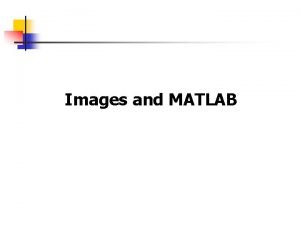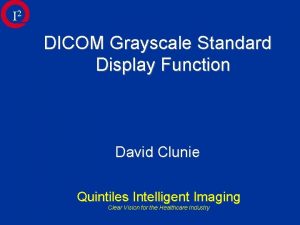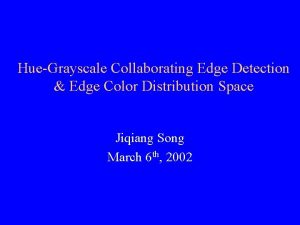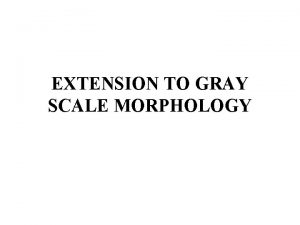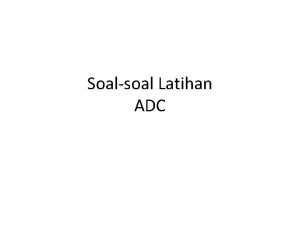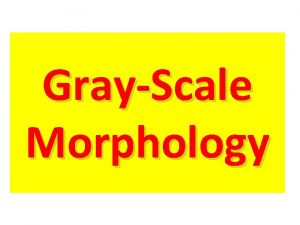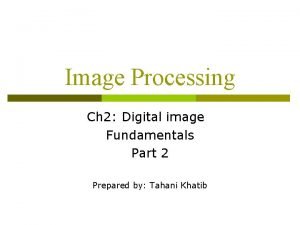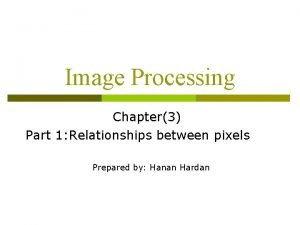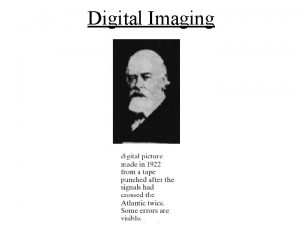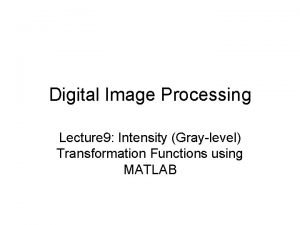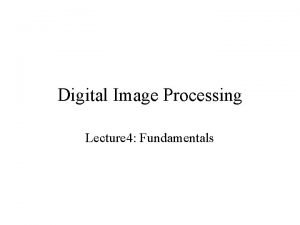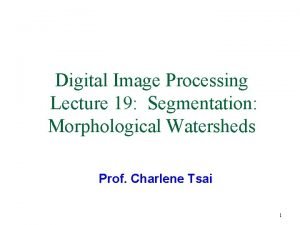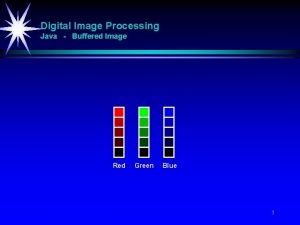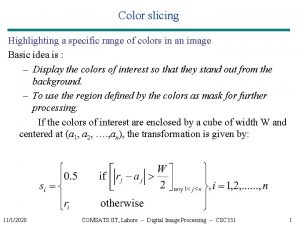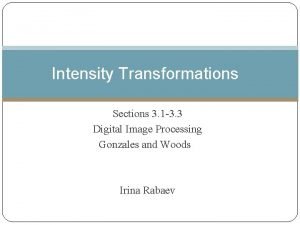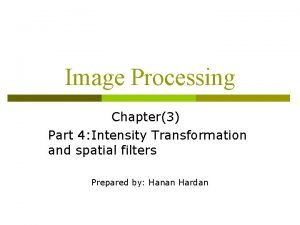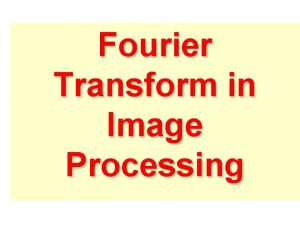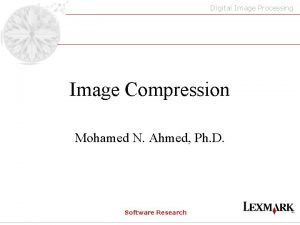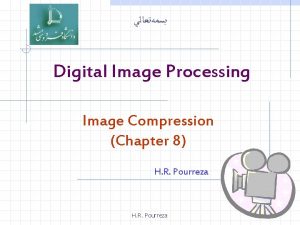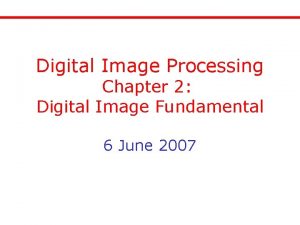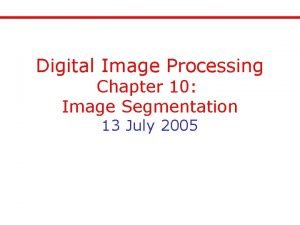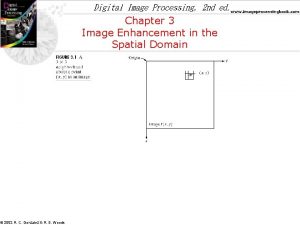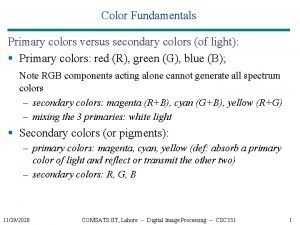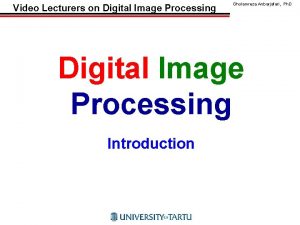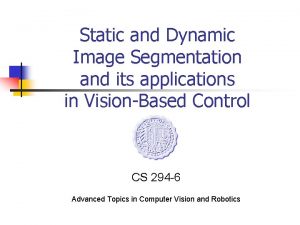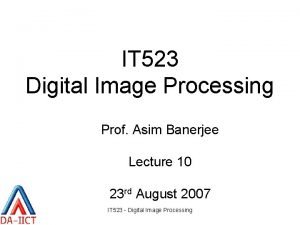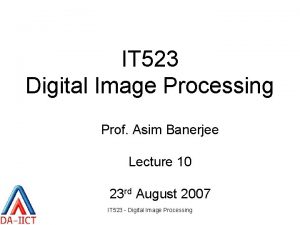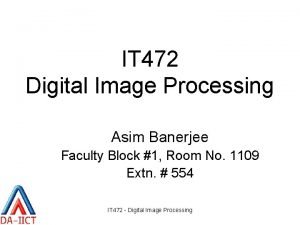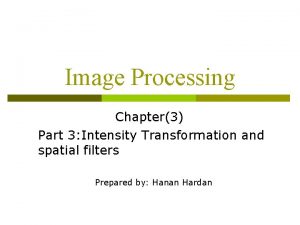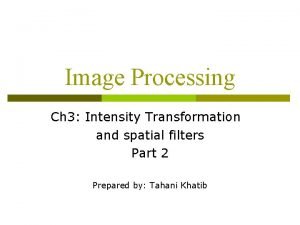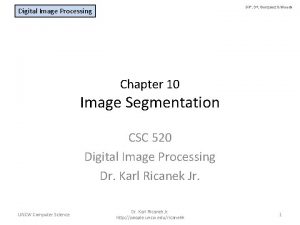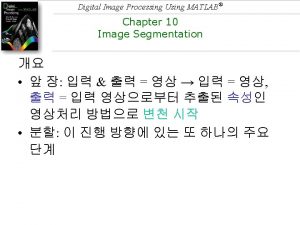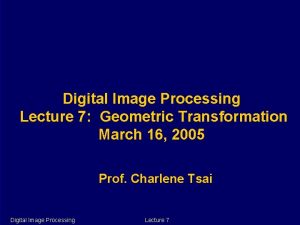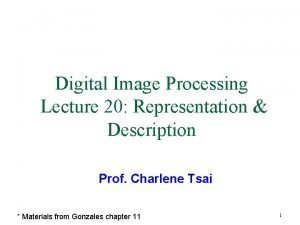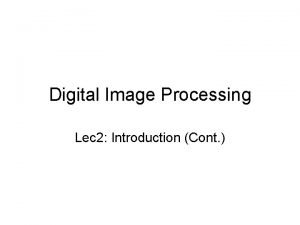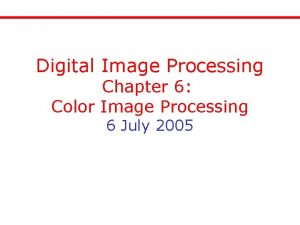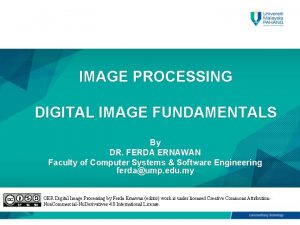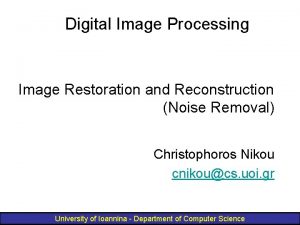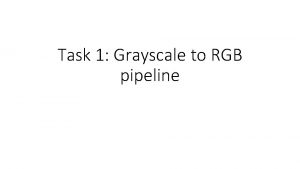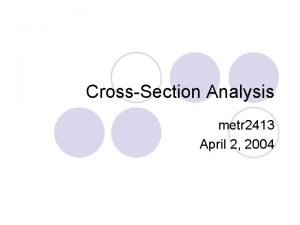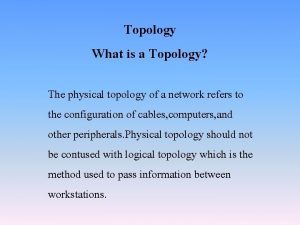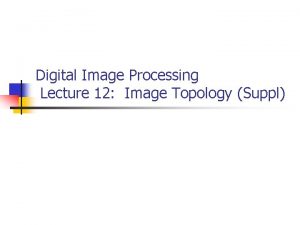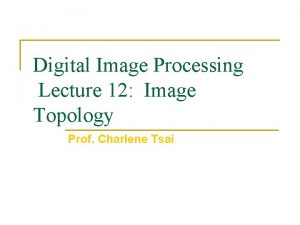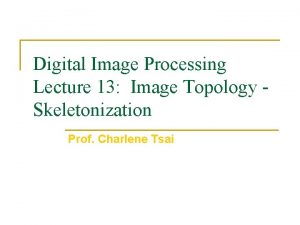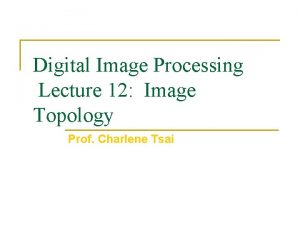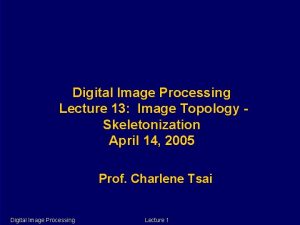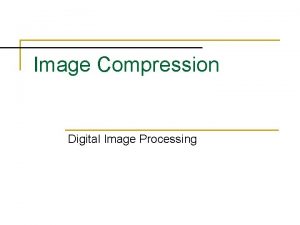Digital topology and crosssection topology for grayscale image































































































































































- Slides: 159

Digital topology and cross-section topology for grayscale image processing M. Couprie A 2 SI lab. , ESIEE Marne-la-Vallée, France www. esiee. fr/a 2 si 1

What is topology ? « A topologist is interested in those properties of a thing that, while they are in a sense geometrical, are the most permanentthe ones that will survive distortion and stretching. » Stephen Barr, "Experiments in Topology", 1964 2

Aims of this talk z Present the main notions of digital topology z Show their usefulness in image processing applications z Study some topological properties of digital grayscale images (ie. functions from Zn to Z) z Topology-preserving image transforms z Topology-altering image transforms z Applications to image processing (filtering, segmentation…) 3

Some milestones z. J. C. Maxwell (1870): ‘On hills and dales ’ z. A. Rosenfeld (1970’s): digital topology z. A. Rosenfeld (1980’s): fuzzy digital topology z. S. Beucher (1990): definition of homotopy between grayscale images z. G. Bertrand (1995): cross-section topology 4

Contributors z. Gilles Bertrand z. Michel Couprie z. Laurent Perroton z. Zouina Aktouf (Ph. D student) z. Francisco Nivando Bezerra (Ph. D student) z. Xavier Daragon (Ph. D student) z. Petr Dokládal (Ph. D student) z. Jean-Christophe Everat (Ph. D student) 5

Outline of the talk Part 1 z. Digital topology for binary images z. Applications to graylevel image processing Part 2 z. Cross-section topology for grayscale images z. Topology-altering transforms, applications 6

Digital topology for binary images z 8 -adjacency, 4 -adjacency in black: X (object) in white: X (background). zpath, connected components 7

Digital topology for binary images z 8 -adjacency, 4 -adjacency in black: X (object) in white: X (background) . zpath, connected components 8

Digital topology for binary images z 8 -adjacency, 4 -adjacency in black: X (object) in white: X (background) . zpath, connected components 9

Digital topology for binary images z 8 -adjacency, 4 -adjacency in black: X (object) in white: X (background) . zpath, connected components 10

More examples Black: 4, white: 8 3 1 Black: 8, white: 4 2 2 11

Jordan property z. Any simple closed curve divides the plane into 2 connected components. 12

Jordan property (cont. ) z. A subset X of Z 2 is a simple closed curve if each point x of X has exactly two neighbors in X 4 -curve 8 -curve 13

Jordan property (cont. ) z. A subset X of Z 2 is a simple closed curve if each point x of X has exactly two neighbors in X Not a 4 -curve 14

Jordan property (cont. ) z. A subset X of Z 2 is a simple closed curve if each point x of X has exactly two neighbors in X Not an 8 -curve 15

Jordan property (cont. ) z. The Jordan property does no hold if X and its complement have the same adjacency 8 -adjacency 4 -adjacency 16

Topology preservation notion of simple point z A topology-preserving transform must preserve the number of connected components of both X and X. z Definition (2 D): A point p is simple (for X) if its modification (addition to X, withdrawal from X) does not change the number of connected components of X and X. 17

Simple point: examples Set X (black points) 18

Simple point: examples Simple point of X 19

Simple point: examples Simple point of X 20

Simple point: counterexamples Non-simple point (background component creation if deleted) 21

Simple point: counterexamples Non-simple point (component splitting if deleted) 22

Simple point: parallel deletion Deleting simple points in parallel may change the topology 23

Simple point: local characterization ? 24

Simple point: local characterization ? 25

Connectivity numbers z T(p)=number of Connected Components of (X - {p}) N(p) where N(p)=8 -neighborhood of p z T(p)=number of Connected Components of (X - {p}) N(p)A U U T=2, T=2 T=1, T=0 Interior point T=0, T=1 Isolated point z Characterization of simple points (local): p is simple iff T(p) = 1 and T(p) = 1 A 26

Skeletons z We say that Y is a skeleton of X if Y may be obtained from X by sequential deletion of simple points z If Y is a skeleton of X and if Y contains no simple point, then we say that Y is an ultimate skeleton of X z If Y is a skeleton of X and if Y contains only nonsimple points and ‘end points’, then we say that Y is a curve skeleton of X 27

End points z. We say that p is an end point for X if (X - {p}) N(p) contains exactly one point U End point (8) Non-end point 28

Skeletons (examples) End points Original image Curve skeleton Ultimate skeleton 29

Homotopy z. We say that X and Y are homotopic (i. e. they have the same topology) if Y may be obtained from X by sequential addition or deletion of simple points 30

Basic thinning algorithms Ultimate thinning(X) Repeat until stability: Select a simple point p of X Remove p from X Curve thinning(X) Repeat until stability: Select a simple, non-end point p of X Remove p from X 31

Centering skeletons 32

Breadth-first thinning Simple points detected during the 1 st iteration Candidates for the 2 nd iteration 33

Breadth-first thinning Breadth-first ultimate thinning(X) T : = X ; T’ : = Repeat until stability While p T do T : = T {p} If p is a simple point for X then X : = X {p} For all q neighbour of p, q X, do T’ : = T’ {q} T : = T’ ; T’ : = 34

Directional thinning z (only in 2 D) North South East West 35

Parallel directional algorithm z In 2 D, simple and non-end points of the same type (N, S, E, W) can be removed in parallel Directional Curve thinning(X) Repeat until stability: For dir =N, S, E, W Let Y be the set of all simple, non-end points of X of type dir X = X Y 36

Does not work in 3 D z In 3 D, there are 6 principal directions: N, S, E, W, Up, Down Up 37

Thinning guided by a distance map z. Let X be a subset of Z 2, the distance map DMX is defined by, for all point p: DMX(p) = min{dist(p, q), q not in X} where dist is a distance (e. g. city block, chessboard, Euclidean) 38

Discrete distances z. City block distance (d 4) d 4(p, q) = length of a shortest 4 -path between p and q z. Chessboard distance (d 8) d 8(p, q) = length of a shortest 8 -path between p and q 39

Discrete distance maps 1 1 1 1 1 2 2 2 2 2 1 1 2 3 3 3 2 1 1 1 2 3 4 4 3 2 1 d 4 1 2 3 3 3 2 1 1 1 2 2 2 2 2 1 1 1 1 1 1 1 2 2 2 2 1 1 1 2 2 3 3 3 2 1 1 2 3 3 4 3 2 1 d 8 1 2 2 3 3 3 2 1 1 1 2 2 2 2 1 1 1 1 40

Discrete and Euclidean distance maps d 8 d 4 de 41

Thinning guided by a distance map: algorithm Ultimate guided thinning(X) Compute the distance map DMX Repeat until stability: Select a simple point p of X such that DMX(p) is minimal Remove p from X Curve guided thinning(X) Id. , replace « simple » by « simple non end » 42

Thinning guided by a distance map: results d 8 d 4 de 43

The 3 D case A topology-preserving transform must preserve: - number of connected components of X - number of « holes » (or « tunnels » ) 44

3 D hole (tunnel) 45

3 D hole (tunnel) 46

3 D-skeletons Surface skeleton Original object Ultimate skeleton Curve skeleton 47

Topological classification of points (G. Bertrand) T=1, T=1 (simple point) T=1, T=2 (2 D isthmus) T=3, T=1 (1 D isthmus) 48

3 D hole closing z. G. Bertrand z. Z. Aktouf (Ph. D) z. L. Perroton 49

3 D hole closing 50

3 D hole closing 51

3 D hole closing T=2, T=1 (1 D isthmus) T=1, T=2 (2 D isthmus) 52

3 D hole closing 53

3 D hole closing algorithm z. Let X be an object and Y be a simply connected set containing X z. We remove iteratively all points x of Y X such that T(x) = 1 (i. e. simple points and 1 D isthmus) 54

3 D hole closing 55

3 D hole closing using a distance map z. The points are processed in an order depending on their distance from X (points far from X are selected first) 56

3 D hole closing using a distance map 57

3 D hole closing using a distance map z. When a point p with T=2 is selected, its removal would create a hole. The value of the distance map for this point (DMX(p)) gives an information on the « size » of the corresponding hole in X. z. We can decide to let a hole open or to close it according to this criterion. 58

3 D hole closing using a distance map 59

3 D hole closing: illustration 60

3 D hole closing: illustration 61

3 D hole closing: illustration 62

Outline of the talk Part 1 z. Digital topology for binary images z. Applications to graylevel image processing Part 2 z. Cross-section topology for grayscale images z. Topology-altering transforms, applications 63

Liver vascular system segmentation z. G. Bertrand z. P. Dokladal (Ph. D) Contrast-enhanced tomography scan of liver (2 -D cut from a 3 -D image) 64

Intensity-guided skeletonization 65

Segmentation results 66

Skeleton Filtering (1) Filtering criterion based on minimum accepted mean luminosity of each skeleton segment. Noisy image Noisy skeleton Identification of Filtered skeleton relevant components 67

Skeleton Filtering (2) Filtering criterion based on detection of irrelevant end points Two criteria based on local information: • mean luminosity • amplitude difference 68

Skeleton Filtering (results) Non filtered Filtered 69

Segmentation of the brain cortex z. M. Couprie z. X. Daragon (Ph. D) z. Basic assumption: the geometry of the brain is complex, but its topology is simple 70

Segmentation of the brain cortex Cortex (gray matter) Cerebrospinal fluid White matter 71

Segmentation of the brain cortex: main steps White matter extraction Pre-segmentation Extension to the cortex Cortex extraction 72

Extraction of the white matter Morphological closing with topological control 73

Morphological closing with topological control A: original image B: opening of A with a small disc C: ultimate skeleton of A in B 74

Extension to the cortex W. M. 75

Extension to the cortex: use of a distance map Section of the 3 D segmentation of the white matter Section of its 3 D distance map (limited to distances < 1 cm) 76

Constraint set: centers of maximal balls Distance map (section) A maximal ball (for a set X) is a ball included in X which is not included in any other ball included in X. The set of the centers of maximal balls for X can be computed from the distance map. Centers of maximal balls 77

Results (sections of 3 D images) Without constraint set With constraint set 78

Results (3 D view) Without constraint set With constraint set 79

Results (3 D view) White matter Cortex 80

Conclusion (1 st part) z. Image simplification with topology preservation z. Controled topology modification z. Binary topological operators guided by a distance map or by a grayscale image z. Efficient implementations 81

Outline of the talk Part 1 z. Digital topology for binary images z. Applications to graylevel image processing Part 2 z. Cross-section topology for grayscale images z. Topology-altering transforms, applications 82

Cross-section topology z. G. Bertrand z. M. Couprie z. J. C. Everat (Ph. D) z. F. N. Bezerra (Ph. D) 83

Cross-section topology z. Basic idea: consider the topology of each cross-section (threshold) of a function. z. Given a function F (Z 2 Z) and k in Z, we define the cross-section Fk as the set of points p of Z 2 such that F(p) k. z. We say that two functions F and G are homotopic if, for every k in Z, Fk and Gk are homotopic (in the binary sense) 84

Homotopy: an illustration F(x, y) y G(x, y) y x x F 3 G 3 F 2 G 2 F 1 G 1 85

Destructible point (G. Bertrand) z. Definition: a point p is destructible (for F) if it is simple for Fk, with k = F(p) . z. Property: p is destructible iff its value may be lowered by one without changing the topology of any cross-section. z. Definition: a point p is constructible (for F) if it is destructible for -F (duality) 86

Destructible point: examples F(x, y) y x F 3 F 2 F 1 87

Destructible point: examples F(x, y) y x F 3 F 2 F 1 88

Destructible point: counter -examples F(x, y) y x F 3 F 2 F 1 89

Destructible point: counter -examples F(x, y) Component deleted Component splitted y x F 3 F 2 Background component F 1 created 90

Connectivity numbers z N+(p) = {q in N(p), F(q) F(p)} z T+(p) = number of Conn. Comp. of N+(p) . z N--(p) = {q in N(p), F(q) < F(p)} z T--(p) = number of Conn. Comp. of N--(p) . z N++, T++, N-, T- : similar z If an adjacency relation (eg. 4) is chosen for T+, T++, then the other adjacency (8) must be used for T-, T-- 91

Connectivity numbers: examples 1 2 1 9 5 1 9 9 9 1 2 8 9 5 8 9 1 1 1 2 1 1 5 1 2 2 1 T+ = 1 T-- = 1 T+ = 2 T-- = 2 T+ = 0 T-- = 1 92

Destructible point: local characterization z. Property: the point p is destructible iff T+(p) = 1 and T--(p) = 1 1 2 1 9 5 1 9 9 9 1 2 8 9 5 8 9 1 1 1 2 1 1 5 1 2 2 1 T+ = 1 T-- = 1 T+ = 2 T-- = 2 T+ = 0 T-- = 1 destructible non-destructible 93

Classification of points (G. Bertrand) z The local configuration of a point p corresponds to exactly one of the eleven following cases: y peak (T+ = 0) y maximal destructible (T+ = T-- = 1, T++ = 0) y maximal divergent (T-- > 1, T++ = 0) y destructible convergent (T+ = T-- = 1, T++ > 1) y well (T- = 0) y minimal constructible (T++ = T- = 1, T-- = 0) y minimal convergent (T++ > 1, T-- = 0) y constructible divergent (T++ = T- = 1, T-- > 1) y interior (T++ = T-- = 0) y simple side (T+ = T-- = T++ = T- = 1) y saddle (T++ > 1, T-- > 1) 94

Classification of points: examples 1 2 1 9 5 1 9 9 9 1 2 8 9 5 8 9 1 1 5 5 5 5 5 Simple side Saddle Interior 1 2 1 1 5 1 2 2 1 1 2 1 9 9 1 1 2 2 9 9 9 1 1 2 1 9 5 9 Peak Maximal destructible Maximal divergent Destructible convergent 95

Grayscale skeletons z. We say that G is a skeleton of F if G may be obtained from F by sequential lowering of destructible points. . z. If G is a skeleton of F and if G contains no destructible point, then we say that G is an ultimate skeleton of F 96

Ultimate skeleton: 1 D example 97

Ultimate skeleton: illustration 98

Ultimate skeleton: illustration 99

Ultimate skeleton: 1 D example Regional minima 100

Ultimate skeleton: 2 D example Original image F Ultimate skeleton G of F Regional minima of F (white) Regional minima of G (white) 101

( 102

Watersheds z. Powerful segmentation operator from the field of Mathematical Morphology z. Introduced as a tool for segmenting grayscale images by S. Beucher and C. Lantuejoul in the 70 s z. Efficient algorithms based on immersion simulation were proposed by L. Vincent, F. Meyer, P. Soille (and others) in the 90 s 103

Watersheds 104

Watersheds: illustration 105

) 106

Ultimate skeleton vs. Watershed line 1 1 1 1 1 6 6 6 6 3 3 3 3 6 3 7 7 7 3 3 3 6 3 7 2 7 5 5 5 6 3 7 7 7 3 3 3 6 3 3 3 3 6 6 6 6 6 1 1 1 1 Ultimate skeleton (non-minimal points) 1 1 1 1 1 6 6 6 6 1 1 6 3 3 3 6 1 1 6 3 7 7 7 3 6 1 1 6 3 7 2 7 3 6 1 1 6 3 7 7 7 3 6 1 1 6 3 3 5 3 3 6 1 1 6 6 6 6 1 Watershed 107 1 1 1 1 1

Ultimate skeleton vs. Watershed line Central point: belongs to the watershed line Central point: does not belong to the watershed line A watershed point cannot be characterized locally 1 1 1 1 1 6 6 6 6 1 1 1 1 1 6 1 7 7 7 1 6 1 7 2 7 1 6 1 7 7 7 1 6 1 1 6 1 1 6 1 1 6 6 6 6 1 108 1 1 1 1 1

Thinness z. In the previous examples, the set of nonminimal points of an ultimate skeleton was « thin » (a set X is thin if it contains no interior point). Is it always true ? z. The answer is no, as shown by the following counter-examples. 109

Thinness 3 3 3 1 1 3 3 3 1 3 1 3 3 1 1 3 3 3 1 1 3 3 3 1 1 3 3 1 3 1 3 3 3 1 1 3 3 3 3 3 3 1 1 1 1 3 3 1 1 1 1 3 3 1 3 2 2 2 3 3 1 1 1 1 3 3 1 1 1 1 3 3 3 3 3 110

Thinness 3 3 3 3 2 2 2 1 3 3 2 2 1 2 3 3 2 1 2 2 3 3 1 2 2 2 3 3 3 3 3 1 1 1 1 3 3 1 1 1 3 3 3 2 3 1 3 2 2 2 3 1 1 3 3 1 3 2 2 2 3 1 1 3 3 3 2 3 1 3 3 1 1 1 3 3 1 1 1 1 3 111 3 3 3 3 3

Basic algorithm Basic ultimate grayscale thinning(F) Repeat until stability: Select a destructible point p for F F(p) : = F(p) – 1 Inefficient: O(n. g), where: n is the number of pixels g is the maximum gray level 112

Lowest is best The central point is destructible: 3 1 1 9 it can thus be lowered down to 5 6 1 9 without changing the topology. 9 9 It can obviously be lowered more: - down to 3 (since there is no value between 6 and 3 in the neighborhood) - down to 1 (we can check that once at level 3, the point is still destructible) 113

Two special values If p is destructible, we define: -(p)=highest value strictly lower than F(p) in the neighborhood of p -(p)=lowest value down to which F(p) can be lowered without changing the topology 3 1 1 9 6 1 9 9 9 Here: -(p)=3 (p)=1 114

Better but not yet good If we replace: F(p) : = F(p) – 1 in the basic algorithm by: F(p) : = (p), we get a faster algorithm. But its complexity is still bad. Let us show why: 115

Fast algorithm Fast ultimate grayscale thinning(F) Repeat until stability: Select a destructible point p for F of minimal graylevel F(p) : = (p) - Can be efficiently implemented thanks to a hierarchical queue - Execution time roughly proportional to n (number of pixels) 116

Complexity analysis: open problem 3 3 3 1 1 1 1 3 3 1 1 1 1 3 3 1 1 4 4 4 1 1 1 3 3 1 4 3 2 1 2 3 1 3 2 1 1 4 1 1 3 3 1 4 3 2 1 2 3 1 2 2 3 3 1 4 3 2 1 2 3 1 3 2 1 4 1 1 3 3 1 1 4 4 4 1 1 1 3 3 1 1 1 1 3 3 1 1 1 1 3 3 3 117

Outline of the talk Part 1 z. Digital topology for binary images z. Applications to graylevel image processing Part 2 z. Cross-section topology for grayscale images z. Topology-altering transforms, applications 118

Topology-altering transforms, applications z. G. Bertrand z. M. Couprie z. J. C. Everat (Ph. D) z. F. N. Bezerra (Ph. D) 119

Altering the topology z. Control over topology modification. z. Criteria: y. Local contrast : notion of -skeleton y. Regional contrast : regularization y. Size : topological filtering y. Topology : crestoration 120

Non-homotopic operators z Topology preservation: strong restriction over segmentation z Our goal: Change topology in a controlled way regional minima segmented regions 121

-destructible point not -destructible Illustration (1 D profile of a 2 D image) 122

-destructible point z. Definition: Let X be a set of points, we define F-(X)=min{F(p), p in X} Let be a positive integer A destructible point p is -destructible A k-divergent point p is -destructible if at least k-1 connected components ci (i=1, …, k-1) of N--(p) are such that F(p) - F-(ci) 123

-skeleton . z. We say that G is a -skeleton of F if G may be obtained from F by sequential lowering of -destructible or peak points 124

-skeleton : example 1 2 1 1 1 2 9 9 5 4 9 2 1 9 1 4 9 1 1 9 1 5 9 9 4 4 1 2 1 1 Original image 1 1 2 1 1 1 1 2 1 2 1 9 9 1 1 1 9 1 1 2 9 1 1 1 9 9 1 1 2 1 1 1 -skeleton ( =3) The order of operations matters 125

-skeleton : examples = 0 = 15 = 30 126

Leveled skeleton z. We say that G is a leveled skeleton of F if G may be obtained from F by sequential lowering of destructible or peak points. 127

Leveled skeleton: example 1 1 2 1 2 7 6 6 8 1 1 9 2 2 8 1 1 7 1 1 9 9 9 8 1 1 1 2 1 1 1 Original image 1 1 2 1 2 6 6 1 1 8 2 2 8 1 1 7 1 1 8 9 8 8 1 1 1 2 1 1 1 After 7 steps 1 1 2 1 2 6 6 1 1 7 2 2 8 1 1 7 1 1 8 8 8 7 1 1 1 2 1 1 1 After 11 steps 128

Leveled skeleton: example 1 1 2 1 2 6 6 1 1 7 2 2 8 1 1 7 1 1 8 8 8 7 1 1 1 2 1 1 1 After 11 steps (reminder) 1 1 2 1 2 6 6 1 1 6 2 2 6 1 1 6 8 6 6 1 1 1 2 1 1 1 After 17 steps 1 1 2 1 2 6 6 1 1 6 2 2 6 1 1 6 6 1 1 1 2 1 1 1 After 18 steps (final result) 129

Leveled skeleton: example Original image Leveled skeleton Regional minima 130

Regularization z. In a leveled skeleton, the regional minima are separated by ‘thin crest lines’ . z. The graylevel on these lines correspond to the ‘altitude of the lowest pass connecting two neighboring minima’ (in the skeleton, and in the original image as well) . z. This allows to detect and modify ‘irregular crest points’ 131

Regularization (cont. ) Leveled skeleton x b a x a b If a > b then x is irregular 132

Regularization: example Original image Regularized leveled skeleton 133

Binary reconstruction Original image Regularized skeleton b a 134

Regularization and reconstruction: segmentation without any parameter Original image Regularized leveled skeleton Binary reconstruction 135

Topological filtering A: original B: thinning+ peak deletion C: reconstruction of B under A 136

Topological filtering (cont. ) Original image 137

Topological filtering (cont. ) Homotopic thinning (n steps) 138

Topological filtering (cont. ) Peak deletion 139

Topological filtering (cont. ) Homotopic reconstruction 140

Topological filtering (cont. ) Final result 141

Comparison with the morphological approach z. Morphological opening (erosion, dilation): makes no difference between a disk of diameter d an elongated object of thickness d. z. Area opening: makes no difference between a disk and an elongated object having the same area 142

Crestoration z. Motivation Original image Gradient Thinning + thresholding 143

Crestoration (cont. ) 0 0 60 240 50 50 50 240 240 50 50 0 60 40 240 50 50 50 60 40 40 90 50 50 50 0 60 40 90 50 50 50 0 0 90 50 50 50 0 0 0 240 50 50 50 0 90 50 50 50 240 240 z p is a separating point if y there is k such that T(p, Fk)=2 z p is extensible if yp is a separating point, and yp is a constructible or saddle point, and y there is a point q in its neighborhood that is an end point or an isolated point for Fk, with k=F(p)+1 50 50 144

Crestoration (cont. ) 0 0 60 240 50 50 50 240 240 50 50 0 60 40 240 50 50 50 60 40 40 90 50 50 50 0 60 40 90 50 50 50 0 0 90 50 50 50 0 0 0 240 50 50 50 0 90 50 50 50 240 240 z p is a separating point if y there is k such that T(p, Fk)=2 z p is extensible if yp is a separating point, and yp is a constructible or saddle point, and y there is a point q in its neighborhood that is an end point or an isolated point for Fk, with k=F(p)+1 50 50 145

Crestoration (cont. ) 0 0 0 240 240 240 50 50 0 60 240 50 50 50 0 0 0 240 240 50 50 0 60 240 50 50 50 0 60 40 240 50 50 50 60 40 40 240 50 50 50 0 60 40 90 50 50 50 0 60 40240 50 50 50 0 0 90 50 50 50 0 90 50 50 0 240 50 50 50 0 60 40 240 50 50 50 0 240 50 50 50 0 0 0 240 50 50 50 0 0 240 50 50 50 0 0 0 0 240 50 50 50 0 240 50 50 50 0 0 240 240 240 50 50 146

Crestoration (cont. ) Thinning + thresholding Gradient Thinning + crestoration + thresholding 147

Crestoration (cont. ) Thinning+ hysteresis thresholding (2 parameters) Thinning + crestoration + thresholding (1 parameter) 148

149

Crest Restoration: result ‘Significant’ crests have been highlighted (in green) Before crestoration: After crestoration: 150

Centering grayscale skeletons Breadth-first ultimate thinning(F) T : = domain of F ; T’ : = Repeat until stability While p T do T : = T {p} If p is a destructible point for F then F(p) : = -(p) For all q neighbour of p, do T’ : = T’ {q} T : = T’ ; T’ : = 151

Breadth-first ultimate thinning : example 152

New strategies to reduce anisotropy z. Generalized Euclidean distance map (computes one distance map for each cross-section) z. Dynamic estimation of Euclidean distance (uses the Danielson’s principle and approximation) 153

Reducing anisotropy: results 154

Reducing anisotropy: results 155

Reducing anisotropy: results 156

Conclusion (2 nd part) z. Strict preservation of both topological and grayscale information z. Combining topology-preserving and topology-altering operators z. Control based on several criteria (contrast, size, topology) z. Strategies to reduce anisotropy 157

Perspectives z. Study of complexity z. Extension to 3 D z. Topology in orders (G. Bertrand) 158

Perspectives z G. Bertrand, J. C. Everat and M. Couprie: "Image segmentation through operators based upon topology", Journal of Electronic Imaging, Vol. 6, No. 4, pp. 395 -405, 1997. z M. Couprie, F. N. Bezerra, Gilles Bertrand: "Topological operators for grayscale image processing", Journal of Electronic Imaging, Vol. 10, No. 4, pp. 1003 -1015, 2001. z www. esiee. fr/~coupriem/Sdi/publis. html 159
 Matlab
Matlab Analog image and digital image
Analog image and digital image Offentlig förvaltning
Offentlig förvaltning Translate
Translate Optimum notch filter in image processing
Optimum notch filter in image processing Compression in digital image processing
Compression in digital image processing Key stages in digital image processing
Key stages in digital image processing Huffman coding example
Huffman coding example Image sharpening in digital image processing
Image sharpening in digital image processing Image geometry in digital image processing
Image geometry in digital image processing Steps of image processing
Steps of image processing Walsh transform in digital image processing
Walsh transform in digital image processing Image geometry in digital image processing
Image geometry in digital image processing Noise
Noise Grayscale standard display function
Grayscale standard display function To grayscale
To grayscale To grayscale
To grayscale Umbra grayscale
Umbra grayscale Grayscale standard display function
Grayscale standard display function Kuantisasi digitalisasi grayscale berjumlah... bit
Kuantisasi digitalisasi grayscale berjumlah... bit Kuantisasi digitalisasi grayscale berjumlah
Kuantisasi digitalisasi grayscale berjumlah Umbra grayscale
Umbra grayscale Grayscale transformation
Grayscale transformation E-commerce digital markets digital goods
E-commerce digital markets digital goods Representation and description in digital image processing
Representation and description in digital image processing For coordinates p(2 3)the 4 neighbors of pixel p are
For coordinates p(2 3)the 4 neighbors of pixel p are Digital photography with flash and no-flash image pairs
Digital photography with flash and no-flash image pairs Regional descriptors in image processing
Regional descriptors in image processing Patterns and pattern classes in digital image processing
Patterns and pattern classes in digital image processing Iso 22301 utbildning
Iso 22301 utbildning Typiska drag för en novell
Typiska drag för en novell Tack för att ni lyssnade bild
Tack för att ni lyssnade bild Ekologiskt fotavtryck
Ekologiskt fotavtryck Shingelfrisyren
Shingelfrisyren En lathund för arbete med kontinuitetshantering
En lathund för arbete med kontinuitetshantering Adressändring ideell förening
Adressändring ideell förening Vilotidsbok
Vilotidsbok Anatomi organ reproduksi
Anatomi organ reproduksi Densitet vatten
Densitet vatten Datorkunskap för nybörjare
Datorkunskap för nybörjare Stig kerman
Stig kerman Debattartikel mall
Debattartikel mall Delegerande ledarstil
Delegerande ledarstil Nyckelkompetenser för livslångt lärande
Nyckelkompetenser för livslångt lärande Påbyggnader för flakfordon
Påbyggnader för flakfordon Lufttryck formel
Lufttryck formel Lyckans minut erik lindorm analys
Lyckans minut erik lindorm analys Presentera för publik crossboss
Presentera för publik crossboss Jiddisch
Jiddisch Plats för toran ark
Plats för toran ark Klassificeringsstruktur för kommunala verksamheter
Klassificeringsstruktur för kommunala verksamheter Mjälthilus
Mjälthilus Bästa kameran för astrofoto
Bästa kameran för astrofoto Centrum för kunskap och säkerhet
Centrum för kunskap och säkerhet Programskede byggprocessen
Programskede byggprocessen Bra mat för unga idrottare
Bra mat för unga idrottare Verktyg för automatisering av utbetalningar
Verktyg för automatisering av utbetalningar Rutin för avvikelsehantering
Rutin för avvikelsehantering Smärtskolan kunskap för livet
Smärtskolan kunskap för livet Ministerstyre för och nackdelar
Ministerstyre för och nackdelar Tack för att ni har lyssnat
Tack för att ni har lyssnat Hur ser ett referat ut
Hur ser ett referat ut Redogör för vad psykologi är
Redogör för vad psykologi är Matematisk modellering eksempel
Matematisk modellering eksempel Tack för att ni har lyssnat
Tack för att ni har lyssnat Borra hål för knoppar
Borra hål för knoppar Vilken grundregel finns det för tronföljden i sverige?
Vilken grundregel finns det för tronföljden i sverige? Hur räknar man standardavvikelse
Hur räknar man standardavvikelse Tack för att ni har lyssnat
Tack för att ni har lyssnat Rita perspektiv
Rita perspektiv Informationskartläggning
Informationskartläggning Tobinskatten för och nackdelar
Tobinskatten för och nackdelar Toppslätskivling dos
Toppslätskivling dos Mästar lärling modellen
Mästar lärling modellen Egg för emanuel
Egg för emanuel Elektronik för barn
Elektronik för barn Kvinnlig mantel i antikens rom
Kvinnlig mantel i antikens rom Strategi för svensk viltförvaltning
Strategi för svensk viltförvaltning Kung dog 1611
Kung dog 1611 Humanitr
Humanitr Ro i rom pax
Ro i rom pax Tack för att ni lyssnade
Tack för att ni lyssnade Vilka tal pekar pilarna på
Vilka tal pekar pilarna på Bunden eller fri form
Bunden eller fri form Inköpsprocessen steg för steg
Inköpsprocessen steg för steg Rbk fuktmätning
Rbk fuktmätning Etik och ledarskap etisk kod för chefer
Etik och ledarskap etisk kod för chefer Exspektans eller expektans
Exspektans eller expektans Myndigheten för delaktighet
Myndigheten för delaktighet Frgar
Frgar Sju principer för tillitsbaserad styrning
Sju principer för tillitsbaserad styrning Läkarutlåtande för livränta
Läkarutlåtande för livränta Karttecken tät skog
Karttecken tät skog Geometri för barn
Geometri för barn Shivaiter
Shivaiter Vanlig celldelning
Vanlig celldelning Bris för vuxna
Bris för vuxna Big brother rösta
Big brother rösta Pengertian warga digital adalah
Pengertian warga digital adalah Digital data digital signals
Digital data digital signals Data encoding and transmission
Data encoding and transmission E-commerce: digital markets, digital goods
E-commerce: digital markets, digital goods Data encoding techniques
Data encoding techniques Luxinnovation logo
Luxinnovation logo Unique features of digital markets
Unique features of digital markets Explain various boundary descriptors.
Explain various boundary descriptors. Threshold image matlab
Threshold image matlab Oerdigital
Oerdigital Explain basic relationship between pixels
Explain basic relationship between pixels Basic intensity transformation functions
Basic intensity transformation functions Digital imaging definition
Digital imaging definition Gray level transformation in digital image processing
Gray level transformation in digital image processing Distance between pixels is called
Distance between pixels is called Coordinate conventions in digital image processing
Coordinate conventions in digital image processing Dam construction in digital image processing
Dam construction in digital image processing Digital image processing java
Digital image processing java Thresholding in digital image processing
Thresholding in digital image processing Filteration
Filteration Digital image processing
Digital image processing Histogram processing in digital image processing
Histogram processing in digital image processing Thresholding in digital image processing
Thresholding in digital image processing What is boundary descriptors in digital image processing
What is boundary descriptors in digital image processing What is color slicing
What is color slicing How to create forensic duplicate of a hard drive
How to create forensic duplicate of a hard drive Power law gamma transformation
Power law gamma transformation Types of spatial filtering in digital image processing
Types of spatial filtering in digital image processing Fourier transform convolution
Fourier transform convolution Matlab
Matlab Digital image processing
Digital image processing Haar transform in digital image processing for n=8
Haar transform in digital image processing for n=8 Coding redundancy in digital image processing
Coding redundancy in digital image processing Jpeg in digital image processing
Jpeg in digital image processing Digital image processing
Digital image processing Color levels
Color levels Filetype:ppt
Filetype:ppt Digital image processing
Digital image processing Color fundamentals in digital image processing
Color fundamentals in digital image processing Digital image processing
Digital image processing Static digital image
Static digital image Point processing operations
Point processing operations Digital path in image processing
Digital path in image processing Digital path in image processing
Digital path in image processing 472
472 Intensity level slicing in image processing
Intensity level slicing in image processing Intensity transformation in digital image processing
Intensity transformation in digital image processing Digital raster graphic image
Digital raster graphic image Digital image processing
Digital image processing Houghpeaks matlab
Houghpeaks matlab Euclidean transformation in digital image processing
Euclidean transformation in digital image processing Laplacian filter
Laplacian filter For a chain code :10103322
For a chain code :10103322 Components of image processing
Components of image processing Point processing
Point processing Image enhancement point processing techniques
Image enhancement point processing techniques Color
Color Morphological dilation
Morphological dilation Hsi color wheel
Hsi color wheel Oerdigital
Oerdigital Formation continue digital
Formation continue digital Digital image processing
Digital image processing
